
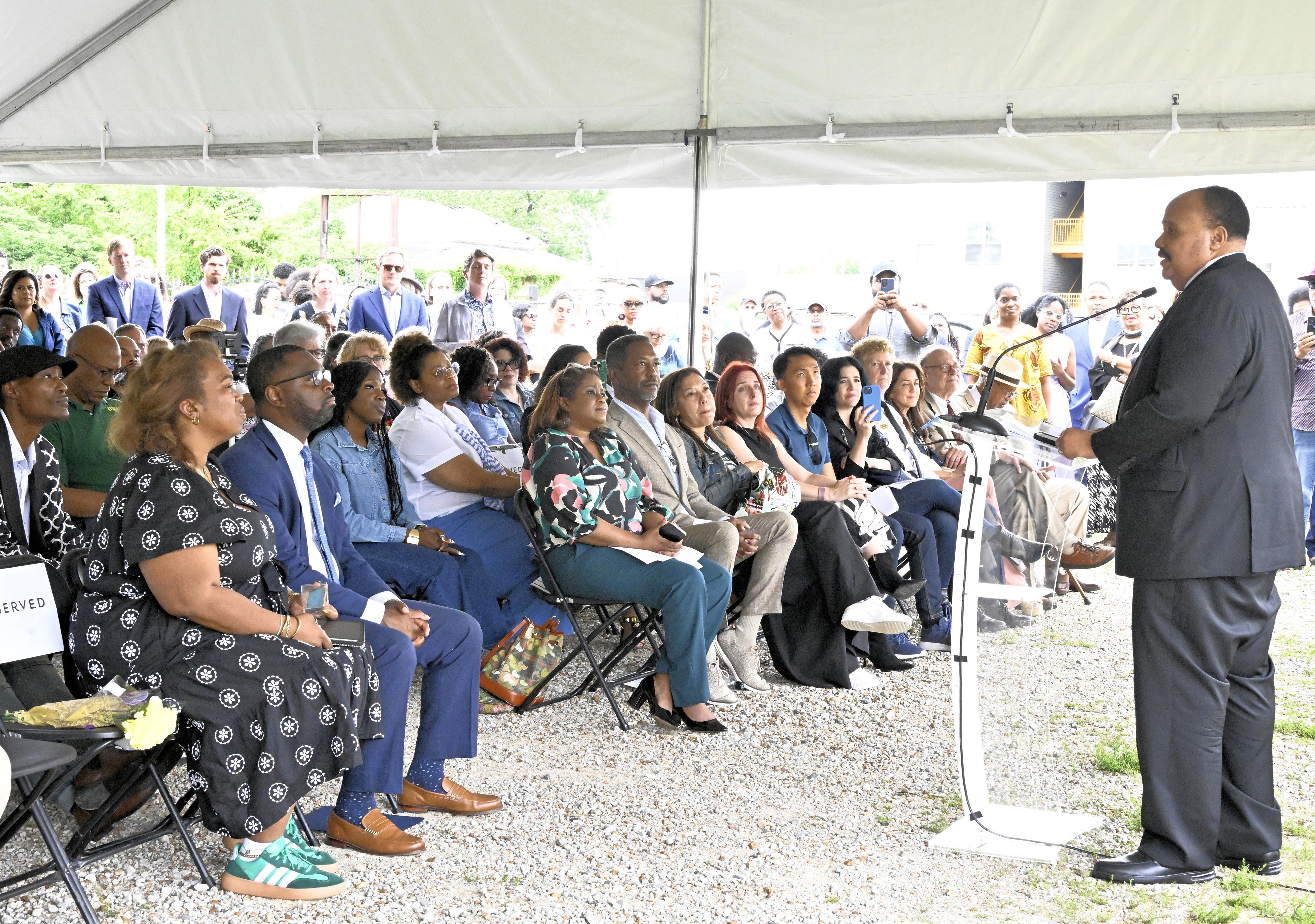







By James Coleman Special to The Tri-State Defender
Shelby County commissioners once again stepped into the void, passing a placeholder property tax rate for the upcoming fiscal year — despite lacking final approval from state officials on the proposed $2.73 rate.
Members approved the rate on a 100-2 vote during their May 19 meeting. Commissioners Edmund Ford Jr. and Britney Thornton abstained. The tax rate must be finalized before the fiscal year 2026 budget can be adopted.
The move came even though commissioners had yet to receive a copy of Shelby County Mayor Lee Harris’ proposed $1.7 billion FY2026 budget. The document had been expected in time for the full commission meeting May 19, but it did not arrive. The next scheduled opportunity for commissioners to review the proposal was during a Budget Subcommittee meeting May 21 at 9 a.m.
Harris was not present during the May 19 rate discussion, and although the May 21 subcommittee meeting offered a chance to present the budget, that presentation did not occur.
“Being told this week we are going to get it — what does that mean? Is that Friday, or is that Thursday? Is it Wednesday?” Thornton asked.
A digital version of the budget was eventually uploaded to the county’s website Thursday, May 22. Go to: 0136FiveYearTrendSummary
The absence of a written proposal earlier in the process further strained relations between Harris’ administration and some commissioners. With a July 1 deadline looming, there are only a few remaining opportunities for members to review the proposal and submit amendments.
Commission Chairman Michael Whaley has scheduled several Budget Subcommittee meetings over the coming weeks.
“Those are opportunities to vet the actual proposed budget and hear those amendments and have them in an order where we can vote on them in an orderly way — to avoid what has happened in the past, which is making very serious, important decisions for the county in the middle of the night,” Whaley said.
Last year, the commission approved a $1.6 billion budget and the current tax rate in a late June session that ran past midnight.
“I think this will help ensure that we can vet as much as possible well before that, so that we’re prepared to vote on a budget that has been properly deliberated,” he said.
Still, some commissioners said
the lack of urgency from colleagues — particularly those with planned amendments — was troubling given the approaching deadline and initial absence of a physical budget.
“There’s too many quiet people up here, as if they already know what they are about to do with this budget,” Ford said. “I’ll see you at wrap-up, because I think it’s already been fixed.”
He also raised concerns that the budget might be balanced “on the back” of the Shelby County Sheriff’s Office. Sheriff Floyd Bonner has previously said this practice could violate the state-mandated “maintenance of effort” law, which requires counties to maintain or increase law enforcement fund-


The Black community has a long history of transforming setbacks into strength by creating, restoring and sustaining legacy sites to preserve its heritage.
By Judith Black Moore Special to The Tri-State Defender
MEMPHIS, Tenn. — Frustration is mounting in Black communities across the country as a wave of recent events calls into question long-standing efforts toward justice, equity and preservation.
In Memphis, jurors acquitted officers in the death of Tyre Nichols, despite widespread public belief that the evidence warranted accountability. Just as Clayborn Temple — a site deeply rooted in the Civil Rights Movement — was nearing completion of a major restoration, it was engulfed in fire. Across the country, diversity, equity and inclusion programs are being dismantled, and every day too many lives are being lost to gun violence despite continued efforts to turn things around.
These moments create a sense of loss, with many fearing that hard-won progress is eroding. Yet history reminds us that every era has faced its own setbacks, and the Black community has always responded with resilience. Time and again, we have refused to passively accept defeat, choosing instead to organize, preserve and build — even rebuild.
From the early 20th-century Rosenwald Schools — where Black communities raised $4.7 million to build schools for children during segregation — to today’s digital archiving efforts, Black people have continually found ways to protect their stories, spaces and institutions. In moments when justice feels out
of reach, this enduring commitment to preservation becomes an act of resistance — an expression of restorative justice that reclaims the right to justice, freedom and self-determination.
In Memphis, Orange Mound stands as a living legacy of that resilience. As the first neighborhood in the United States built for and by African Americans, it has become the focus of local revitalization efforts aimed at reclaiming property, building economic strength and preserving cultural identity.
Across the country, historically Black colleges and universities have remained central to Black advancement, even as they face ongoing underfunding threats and accreditation challenges. One of the most enduring sources of support has come from the Divine Nine — the nine historically Black fraternities and sororities founded in the early 20th century. Through unified fundraising campaigns, scholarship programs and national awareness efforts, these organizations have collectively raised millions to ensure HBCUs continue educating generations of Black scholars. Their advocacy reflects a deep, shared commitment to sustaining institutions that have long served as pillars of leadership, empowerment and academic excellence. Religious institutions have played a critical role in restorative justice, including building and supporting HBCUs. In 1882, the Christian Methodist Episcopal Church founded Lane College in Jackson, Tennessee, securing
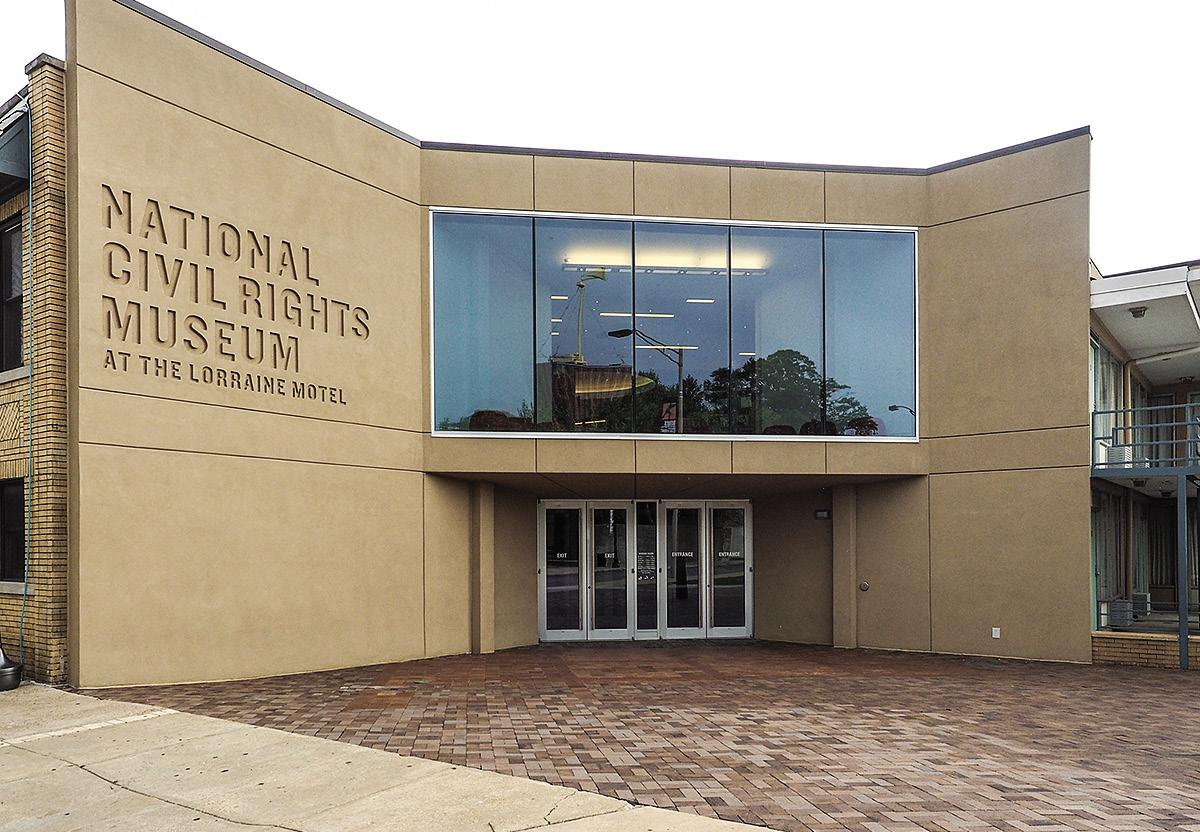
land and leadership to educate newly freed African Americans. That support has spanned generations — not only through Lane, but also through Paine College in Augusta, Georgia, and Texas College in Tyler. Today, Black churches remain vital sources of funding, mentorship and community engagement in the ongoing fight to preserve and protect Black institutions.
Preservation efforts also extend into cultural and historical spaces. Since 2017, the African American Cultural Heritage Action Fund has raised more than $150 million to restore and protect sites of Black historical significance. These places serve not only as reminders of our past but also as anchors for future identity and belonging.
This work includes preserving the history of some of the most horrific chapters in Black history — particularly the stories of racial terror lynchings.
The Lynching Sites Project, a Memphis-based organization, is committed to ensuring the painful legacy of lynching is never forgotten.
“If we in the Black community do not embrace our historical places and stories, I don’t think the generations following us are going to have a clue as to how to
deal with institutional racism,” said John Ashworth, the Lynching Site Project’s former executive director and president, now serving on the board. “Knowing our history and knowing the stories will arm our youth to better navigate their way through institutional racism.”
By identifying, marking and sharing the stories behind lynching sites, the project helps communities confront the deep roots of racial violence and systemic racism, offering vital perspective on how these injustices continue to shape Black lives today.
“I believe there is a direct connection between lynching victims and what we are dealing with today. ..., if we truly understand things that happened, we will be able to forge a way. This is why it is important to know and embrace our historical places and stories.”
Despite today’s setbacks and frustrations — legal, political or cultural — the deeper story is one of recovering, restoring and reflecting on what matters.
To learn more about restoring the local Black landmarks sited in this story and others across the country, visit https://clayborn.org/, https://lynchingsitesmem.org/ and savingplaces.org/ african-american-cultural-heritage



By Jason Roberts BlackPressUSA Newswire
While America’s childcare supply grew nationally, the price of that care continues to rise — placing affordable, high-quality care out of reach for many families. A new report released by Child Care Aware® of America (CCAoA), Child Care in America: 2024 Price & Supply, shows that despite promising signs of increased supply, affordability remains a major barrier — and underscores the need for increased sustained federal and state investment.
From 2023 to 2024, the number of childcare centers increased by 1.6% (to 92,613) and the supply of licensed family childcare (FCC) homes increased by 4.8% (to 98,807). The national growth in FCC homes’ supply is driven largely by four states (CA, KS, MA, VA) and is especially notable as it reverses a yearlong downward trend.
At the same time, the national average price for childcare rose by 29% from 2020 to 2024, outpacing inflation and exceeding other major family household expenses like rent or mortgage payments in many states. Childcare is now so expensive that it consumes 10% of a married-couple-with-children’s median household income and a staggering 35% for a single parent. In most states, families pay more for childcare than rent, mortgage payments or in-state university tuition.
“Childcare supply is increasing, and that is a win, but it’s not enough,” said Susan Gale Perry, CCAoA chief executive officer. “Recent federal and state pandemic-era investments have stabilized and grown supply in some places, but a significant supply gap still

exists — especially in rural communities and for infants and toddlers. We also still haven’t put a dent in affordability for working families. That’s why we urgently need increased funding and new solutions.”
CCAoA’s Childcare in America: 2024 Price & Supply report also found that:
• The average price of childcare increased by 29% from 2020 to 2024, outpacing the national inflation rate of 22%.
• In 45 states plus Washington, DC, the average annual price of center-based childcare for two children exceeded mortgage payments, in some states by up to 78%.
• In 49 states plus Washington, DC, the price of center-based childcare for two children exceeded median rent
payments ranging from 19% to over 100%.
• In 41 states plus Washington, DC, infant care in a center cost more than in-state university tuition.
CCAoA urges policymakers to increase childcare funding at both state and federal levels to maintain the momentum of growing supply, address rising prices and expand access to childcare for families. Federal funding increases have fallen short of the need, and its research shows that total state investments in child care or preschool vary widely from state to state, putting children, families and communities across America on an uneven playing field. Further, targeted investments in childcare supply building and stabilization and childcare workforce re-
cruitment and retention strategies are essential to help sustain an adequate supply of high-quality childcare options nationwide.
CCAoA is the only national organization that supports every part of the childcare system. Together with an on-the-ground network of people doing the work in states and communities, it provides research that drives effective practice and policy, building strong child care programs and professionals. It helps families find and afford quality child care, delivers thought leadership to the military and direct service to its families, and provides a real-world understanding of what works and what doesn’t to spur policymakers into action and help them build solutions.

By Lauren Burke BlackPressUSA Newswire
Charles B. “Charlie” Rangel, the longterm Congressman and a heavyweight in New York politics as a member of Harlem’s”Gang of Four,” died Monday at 94.
His family confirmed the death in a statement provided by City College of New York spokesperson Michelle Stent. He died at a hospital in New York, Stent said.
Rangel’s colorful and charismatic personality, bowties, and raspy voice made him a character on Capitol Hill who was impossible to forget. He was simultaneously larger than life but also approachable and engaging.
Rangel was the last living member of the “Gang of Four,” made up of powerful African American leaders in New York: David Dinkins (1927-2020), Basil Paterson (1946-2014), and Percy Sutton (1920-2009). The four dealmakers were powerbrokers at a time when political decisions were made in smoke-filled rooms over poker games.
In 2010, President Obama suggested that Rangel resign from Congress “with dignity” after he was targeted by an ethics investigation that would eventually mean he had to give up the Chairmanship of the Ways & Means Committee. “This guy from Lenox Avenue is retiring with dignity,” Rangel would later tell reporters as he departed Congress on his terms and at the time of his choosing.
Rangel ignored Obama and remained in Congress for another six years with an aura that made many forget about the ethics investigation.
Before serving Congress, Rangel did about every job in politics that existed. In 1961, Rangel was appointed by Attorney General Robert F. Kennedy
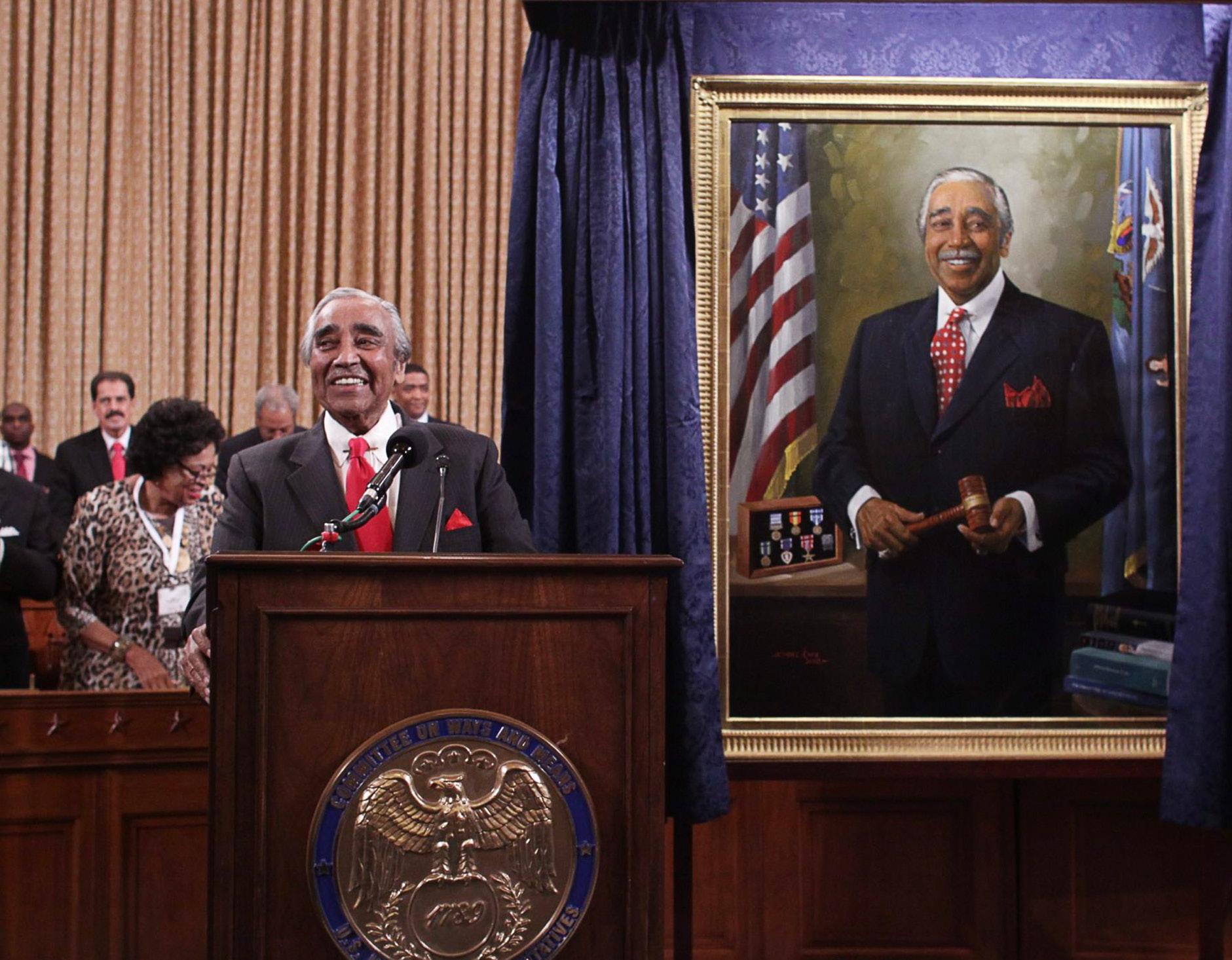
to be an assistant U.S. attorney in the Southern District of New York. Rangel was also a legal counsel for the New York Housing and Redevelopment Board.
Charlese Bernard Rangel was born in Harlem in 1930. He would go on to represent one of the most storied parts of Manhattan for 46 years in the U.S. Congress. Along with the late Congressman John Conyers, Rangel was a founding member of the Congressional Black Caucus.
“We all have a large stake in preserving our democracy, but I maintain that those without power in our society, the black, the brown, the poor of all colors, have the largest stake not because we have the most to lose, but because we have worked the hardest, and given the most, for what we have achieved,” Rangel once said.
Rangel was the first African American to serve as chairman of the
powerful House Ways and Means Committee. As chair and as a member of Ways and Means, Rangel played a central role in shaping U.S. tax legislation. He advocated for progressive tax reform, closing corporate loopholes, and increasing tax equity. Rangel was also a strong supporter of Social Security and Medicare and defended and expanded programs aimed at reducing poverty and supporting working-class families. He also championed federal investment in affordable housing and urban infrastructure, especially for Harlem and other underserved communities.
In a noteworthy policy move, Rangel also pushed to reinstate the military draft during the Iraq War — not to promote it, but to spark debate on the fairness of who bears the burden of war. Rangel earned a Purple Heart and a Bronze Star for valor for his service in the Army during the Korean War.
“We all have a large stake in preserving our democracy, but I maintain that those without power in our society, the black, the brown, the poor of all colors, have the largest stake not because we have the most to lose, but because we have worked the hardest, and given the most, for what we have achieved.”
— Charles B. “Charlie” Rangel
Rangel served as a member of the New York State Assembly from 1967 to 1971 and went on to defeat another New York political legend — Adam Clayton Powell Jr. — in a primary, before winning in the general election in 1970. Rangel retired from Congress in 2016 at 86 years old.
At a time when many are discussing the age of members of Congress and the many who have died in office over the past two years, Rangel was an exception who departed on his terms. His seat in Congress would go to Dominican-born Adriano Espaillat. The moment represented a shift in Harlem’s demographics and the power of the Latino community in the Bronx.
Rangel’s wife Alma Carter died last year. The two met in the 1950s at the famous Savoy Ballroom in Harlem and married in 1964. Rangel is survived by their son, Steven, their daughter, Alicia Rangel Haughton, and three grandsons.
The Associated Press contributed to this report.

By Terri Schlichenmeyer Special to the Tri-State Defender
“Use your brain!”
If you had a dime for every time a teacher, parent or supervisor told you that, you’d be rich. Stop fooling around. Consider what you’re about to do. Act with resolve, not impulse. It’s the best way to work, the optimal method for learning and, as in the new book “The Battle for the Black Mind” by Karida L. Brown, it’s what so many have fought for.
In the months after the Civil War ended, it became apparent to both Black and white people in both the North and South that education for four million suddenly freed former slaves was “a matter of national security.” It was obvious that those citizens would require formal learning soon, maybe job training. But what kind and how much?
While Mary Smith Peake had “laid the foundation” for Hampton University by then, two white men with vastly different intentions traveled south after the war to seize control of Black education. Edmund Asa Ware, who became the first president of Atlanta University (now Clark Atlanta University) built schools that “aimed at nurturing Black intellectualism and potential,” while General Samuel Chapman Armstrong, who was the first president of Hampton Normal and Agricultural Institute (now Hampton University) had plans to “’civilize’” formerly enslaved people through physical labor and farm work.
Booker T. Washington was one of Armstrong’s best-known protegees.
In 1881, Washington became the first president of Tuskegee Institute and was later instrumental in forming the “Tuskegee Machine” which, says Brown, didn’t altogether help “Black families and shoved a singular curriculum down their throats.” There were 45 Black colleges and universities in America then, though education for most Black children was still lacking. It remained so during the Jim Crow era when, although literacy rates grew, education beyond a few years of elementary school was “rare” for Black Americans. By then, says Brown, Black women had stepped up to do the work, becoming teachers, bookkeepers, experts in strategy, fundraisers, staffers, managers and marketers — sometimes, all at once.
Blending personal observations and experiences with good backgrounding, the author tells this story in a conversational tone that invites readers to peek down the halls of history’s HBCUs and into classrooms. She writes to readers, rather than at them, which helps to open minds for what’s inside “The Battle for the Black Mind.”
You may not need to be reminded about racism in Black American education, but the secrets she shares and the lines she draws are highlighted to seem like new information. Here, readers can see more clearly the connections between the early twentieth-century and now, and how Project 2025 could change the trajectory. Fortunately, Brown also offers advice and ideas

“The Battle for
Black Mind” by Karida L. Brown c.2025, Legacy Lit
for taking action and ensuring that upcoming generations can win the next “battle.”
“The Battle for the Black Mind” is a lively book that you can read for in-
$30.00
256 pages
formation, history or just because. But beware: It might make you want to get up, contact your senator or representative, and act. It’s the kind of book that’ll make you think.

WMC, the NBC affiliate serving Memphis and the Mid-South, has appointed Kevin Lightfoot as its next news director. A seasoned newsroom leader with more than 20 years of experience in major markets across the country, Lightfoot brings a strong track record of editorial leadership and a passion for effective, community-focused journalism, the station announced in a news release Friday.
Lightfoot most recently served as assistant news director at WCBS, the CBS-owned station in New York City. Before joining WCBS, he was executive producer at KTRK, the ABC/ Disney-owned station in Houston, Texas, where he helped guide coverage in one of the nation’s most competitive news environments. His earlier career includes news management roles in Orlando, Florida, and Jackson, Mississippi.
“We’re thrilled to welcome Kevin to Gray (Local Media, Inc.) and have him lead WMC’s newsroom into its next chapter,” said Jonathan Mitchell, vice president and general manager of WMC. “Kevin’s depth of experience and passion for impactful journalism make him the perfect leader to build on our momentum and shape the future of local news in Memphis.”
“The team of journalists at WMC is exceptional, their commitment to impactful, enterprise journalism is inspiring,” said Lightfoot. “I’m honored










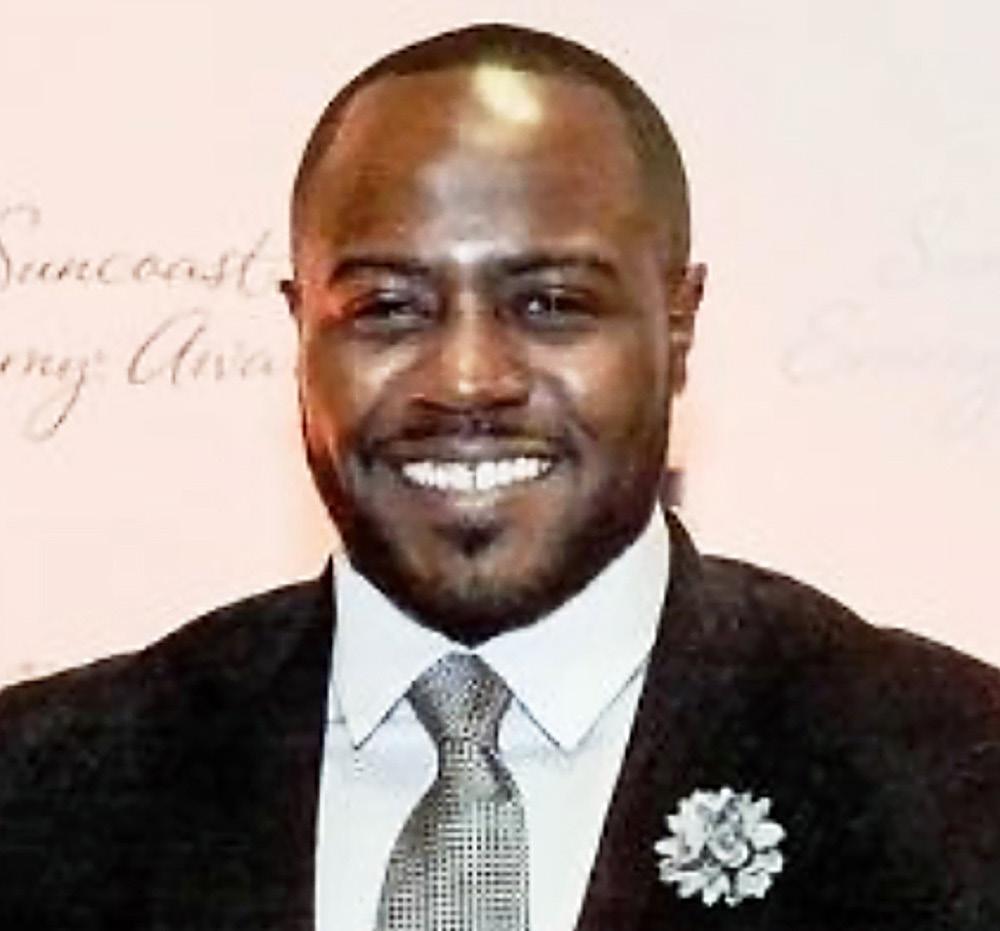



to join such a dedicated newsroom and excited to hit the ground running in Memphis.”
An alumnus of Hampton University’s Scripps Howard School of Journalism, Lightfoot graduated with honors and served on the executive board of the university’s chapter of the National Association of Black Journalists. He is a longtime member of NABJ and has held numerous leadership roles in the organization, including president of the Jackson chapter, vice president of the Houston chapter and treasurer of the New York City chapter.
Born in New York City and raised in New Jersey, Lightfoot is a father of three boys and a passionate fan of the New York Giants, Yankees and Knicks.













By Lee Eric Smith Special to The Tri-State Defender
It took more than two decades for something new to take root at the old Southwest Twin Drive-In site in Westwood.
But on an overcast May morning, with golden shovels in hand and hundreds gathered in anticipation, city and county officials broke ground on a $30 million redevelopment project they believe will transform the area.
At the heart of that transformation are a new Memphis Public Library branch and a new Memphis Police Department precinct — key civic investments that County Commissioner Edmund Ford Jr. believes can serve as a magnet for broader development.
Ford pointed to a similar redevelopment that transformed the Raleigh Springs Mall site into an MPD precinct and library space. He said he noticed some changes at the intersection of Yale Road and Austin Peay Highway.
“I looked and said, ‘Okay, where did that Chick-fil-A come from?’ There’s a Truist Bank, a (new) car wash, a Valvoline Oil Change. A Whataburger. They got a Starbucks over there. Did you know that?
“Do you think those things would have been there if they did not start off with the first phase of a police station or a library? I don’t think so,” Ford said.
That kind of growth is the goal of city leaders and residents alike — to replace blight with opportunity, to bring back neighborhood pride and to plant seeds for sustained revitalization in one of Memphis’ most historic communities.
“For too long, this 30-acre site was overlooked and undervalued,” said Memphis Mayor Paul Young. “But the City of Memphis believes in the com-
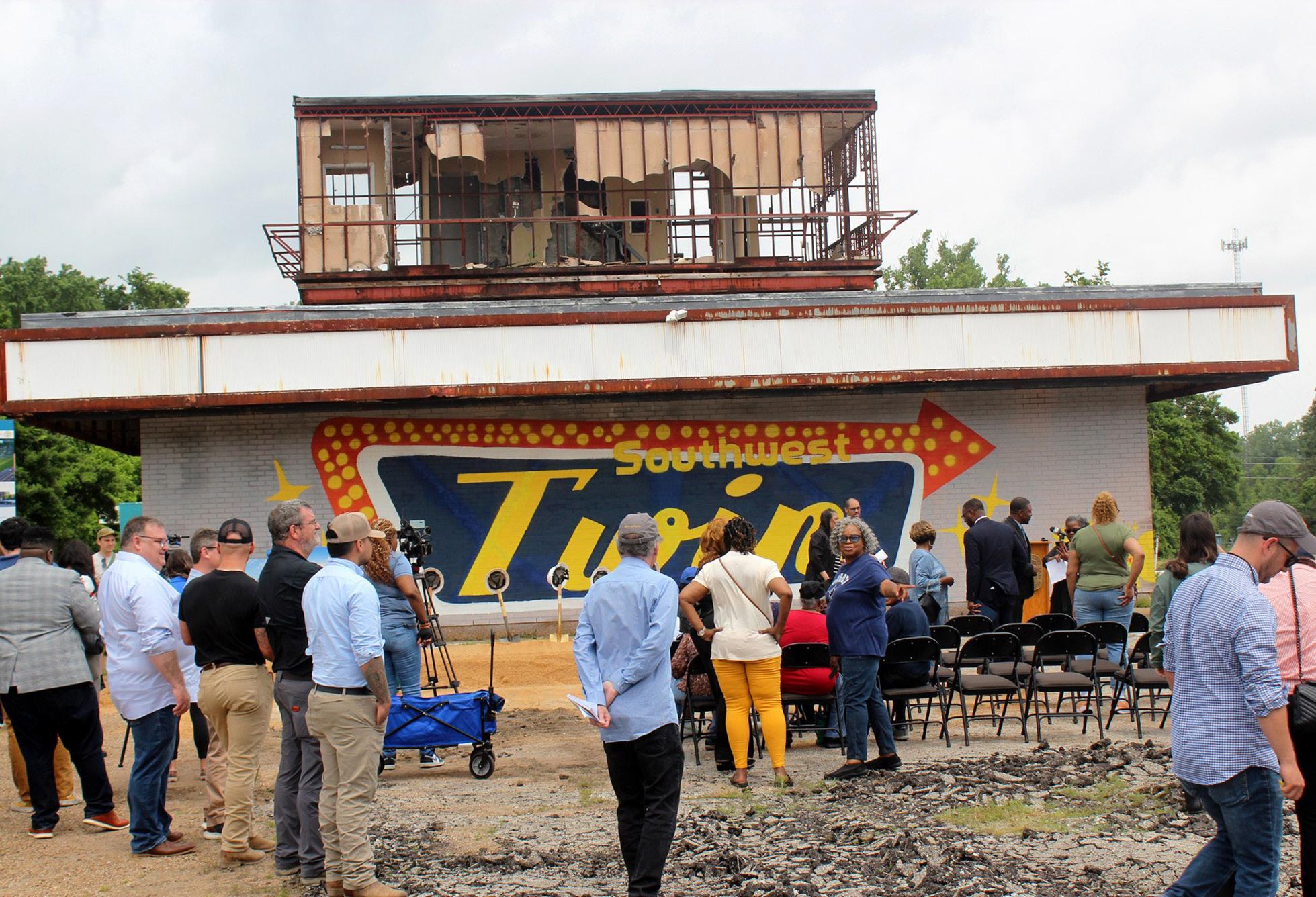
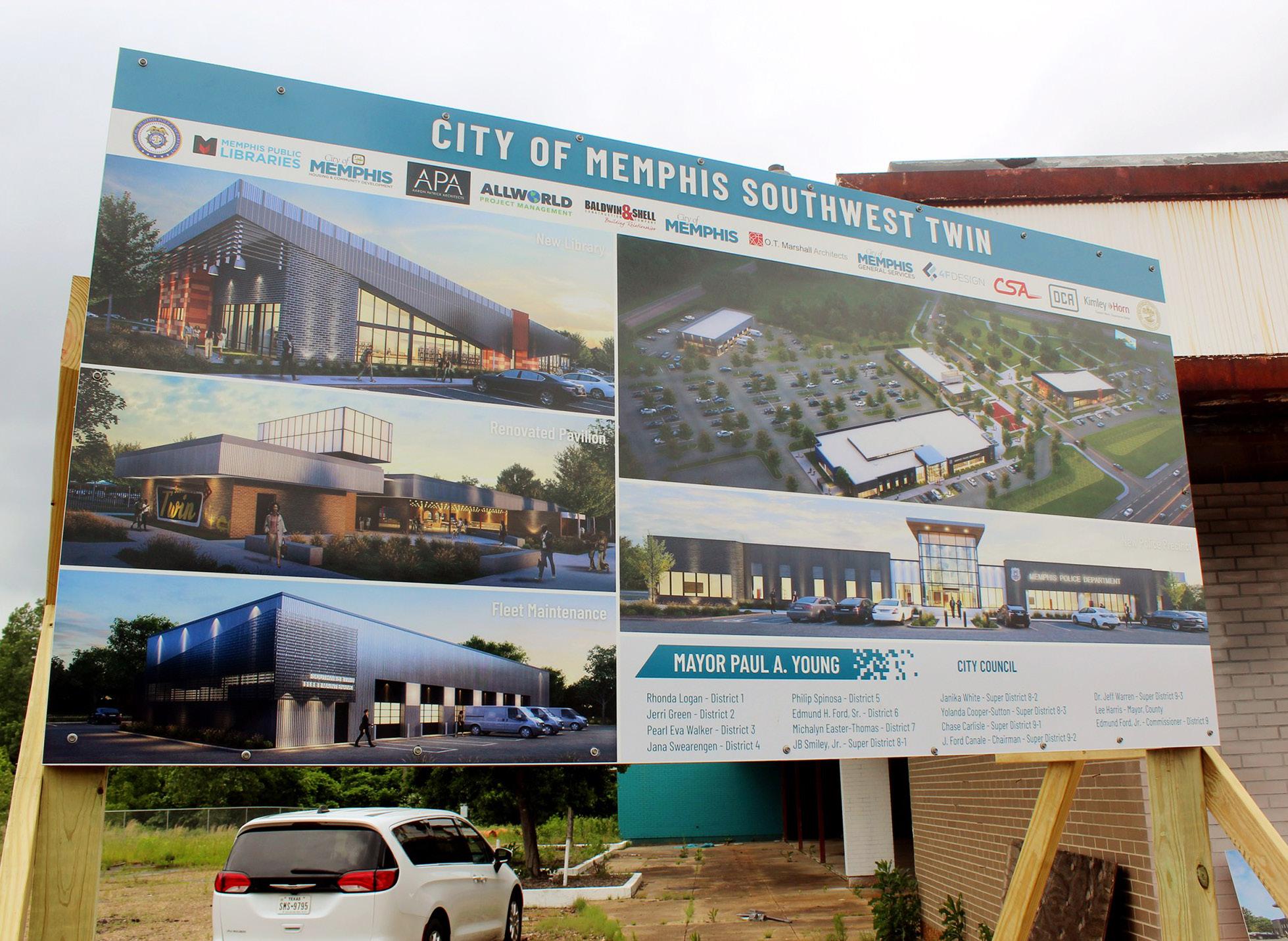
munity-lifting power of this space.”
The Southwest Twin Drive-In opened in 1956 and closed in 2001. In the years since, the site became a symbol of decay — until the City of Memphis and Shelby County allocated $1 million each toward redevelopment planning.
Friday’s groundbreaking is the result of that momentum, with Baldwin & Shell serving as general contractor and Aaron Patrick Architects leading the design team.
In his remarks at the groundbreaking, Young framed the moment as more than a construction milestone.
“This is more than redevelopment,” he said. “It’s restoration. It’s about meeting long-standing needs, honoring community voices and building a future that’s rooted in dignity and opportunity.”
City councilman Edmund Ford Sr., who represents the district and has long championed improvements in the area, took a more plainspoken tone.
“We don’t want no junk. We want something worthwhile,” he said. “I don’t trust the banks no more, but we’re already talking to a credit union about coming out here.”
The new library is planned to serve residents of all ages with access to books, technology, career resources and creative programming. The new police precinct is expected to strengthen relationships between law enforcement and the community, in addition to improving public safety.
Felicia Harris, deputy director of Housing and Community Development, thanked city partners and led attendees in a moment of silence for Housing and Community Development Director Ashley Cash, who is mourning the loss of a family member.
“Westwood is on the move,” Harris said. “This is just the beginning.”

By Lee Eric Smith Special to The Tri-State Defender
A month ago, Anasa Troutman stood on this same ground, weeping, inconsolable. Clayborn Temple — a civil rights landmark and sacred space she’d spent years helping restore — was going up in flames just yards away.
“It has been a month of tears, a month of really hard conversations, a month of watching Memphians from all walks of life pull up to this curb and walk up to that wall and wail,” she said.
Standing just steps from the scorched building Wednesday, Troutman, surrounded by hundreds of supporters, shed more tears. But this time, what moved her was a growing chorus of support for the rebirth of Clayborn Temple.
Brent Leggs, senior vice president of the National Trust for Historic Preservation, took the stage during a news conference to announce that a $1.5 million collective grant from the National Trust, the Mellon Foundation, and the Ford Foundation has been awarded to support Clayborn Temple’s stabilization and reconstruction.
“There was never one doubt that we were not going to rescue this irreplaceable history,” Leggs told The Tri-State Defender. “It was just, what’s the strategy? How fast can we move?”
The National Trust has worked with Troutman’s team since 2017, when Clayborn was officially designated a National Treasure. This new grant is

meant to fund immediate action: securing the site, assessing structural needs, and jumpstarting long-term planning.
“It’s one thing to say, ‘We’re going to rebuild,’” Leggs said. “It’s another thing to come with money that does just that.”
More than a historic site, he said, Clayborn Temple holds memory, identity, and movement in its walls — especially for Black America.
“These spaces connect us to who we are and who we aspire to be. This is about permanence — making sure our sacred spaces remain standing for generations to come,” Leggs said.
Martin Luther King III: “the place where my father was taken from me”
Standing in solidarity with Biggs was Martin Luther King III, whose father
famously rallied striking sanitation workers from Clayborn’s pulpit just days before his assassination in Memphis.
“It is always somewhat of a daunting task for me to return to this city,” he said quietly. “Because for me, it will always be the place where my father was taken from me.”
He spoke with conviction, recalling how Dr. King’s family home and

“There was never one doubt that we were not going to rescue this irreplaceable history.”
churches had also been bombed. “You’d think in 2025, we’d be a more loving, more engaged nation,” he said. “But apparently, we still have work to do.” King, joined by his wife, Arndrea Waters King, also reminded the crowd why Clayborn Temple matters — not just as a symbol of Memphis’ civil rights legacy, but as a sanctuary for working-class dignity. He reflected on the pivotal role the church played during the 1968 sanitation workers’ strike, when Black men demanded not only fair wages, but recognition of their humanity.
“Some of our most important workers in all of our communities,” he said, describing the striking men who marched each day wearing signs that read I AM A MAN. “Because if one day — well, certainly two or three days — (sanitation workers) didn’t show up, our cities would be filled with trash. We wouldn’t know what to do.”
That fight for dignity, he said, remains unfinished. “Today, we still owe sanitation workers — wherever they are — a great debt,” King told the crowd. “And places like Clayborn Temple help us remember that.”
Memphis Mayor Paul Young described the day as both emotional and affirming.
“This is a place that has been at the center of the civil rights movement for many years,” Young said. “Being here today is a powerful statement that we will all work together to make its future even brighter.”
He described a vision for Clayborn’s rebirth — not just as a restored building, but as a sacred gathering space for reflection, dialogue and community. “Whether you’re from Memphis or visiting, I want you to be able to stand here, feel the history
and know the story.”
Among other elected officials on hand to deliver remarks: U.S. Congressman Steve Cohen, (D-TN), and Memphis City Council Chair Ford Canale.
“Let me be clear: this act of violence will not break our spirit,” Canale said. “The story of Clayborn Temple is not over. In fact, its next chapter is just beginning.”
“We wanted people to take a piece of Clayborn home.”
As the program wound down, Troutman shared one final story — one that brought her full circle, from grief to grace.
Months before the fire, her team had carefully removed the stained-glass windows as part of a preservation phase. Some of that salvaged glass had been cut into small squares and given to supporters as keepsakes — an invitation, she said, “for people to take a piece of Clayborn home with them.”
She hadn’t expected to see one of those pieces again.
But as she stepped out of her car that day, someone in the crowd walked up and placed one in her hand.
“Raymond, where are you?” she called out from the stage. “He said, ‘I want you to have this, and I want you to keep it forever.’ And I’m going to keep it forever.”
She held it up — light catching in its colored glass, a flicker of what once was and what could be again. She held it aloft as the crowd looked on.
“We will rebuild this building,” she said. “But our real work is to build a dignified future. One where every single Memphian can experience joy, safety, and abundance — no matter what neighborhood they live in.”
She paused, tears catching again.
“I love this city,” she said. “And I’m never leaving.”
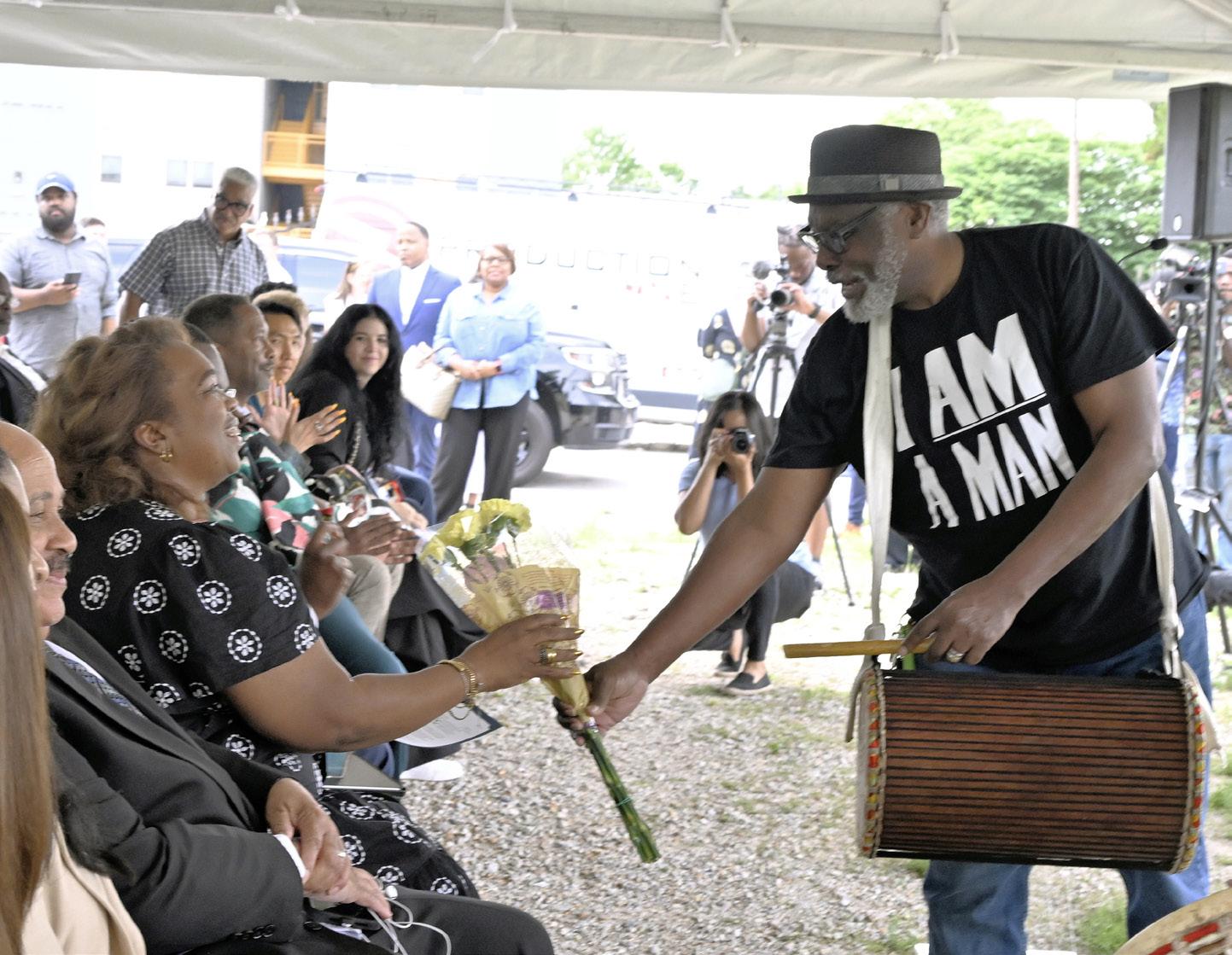
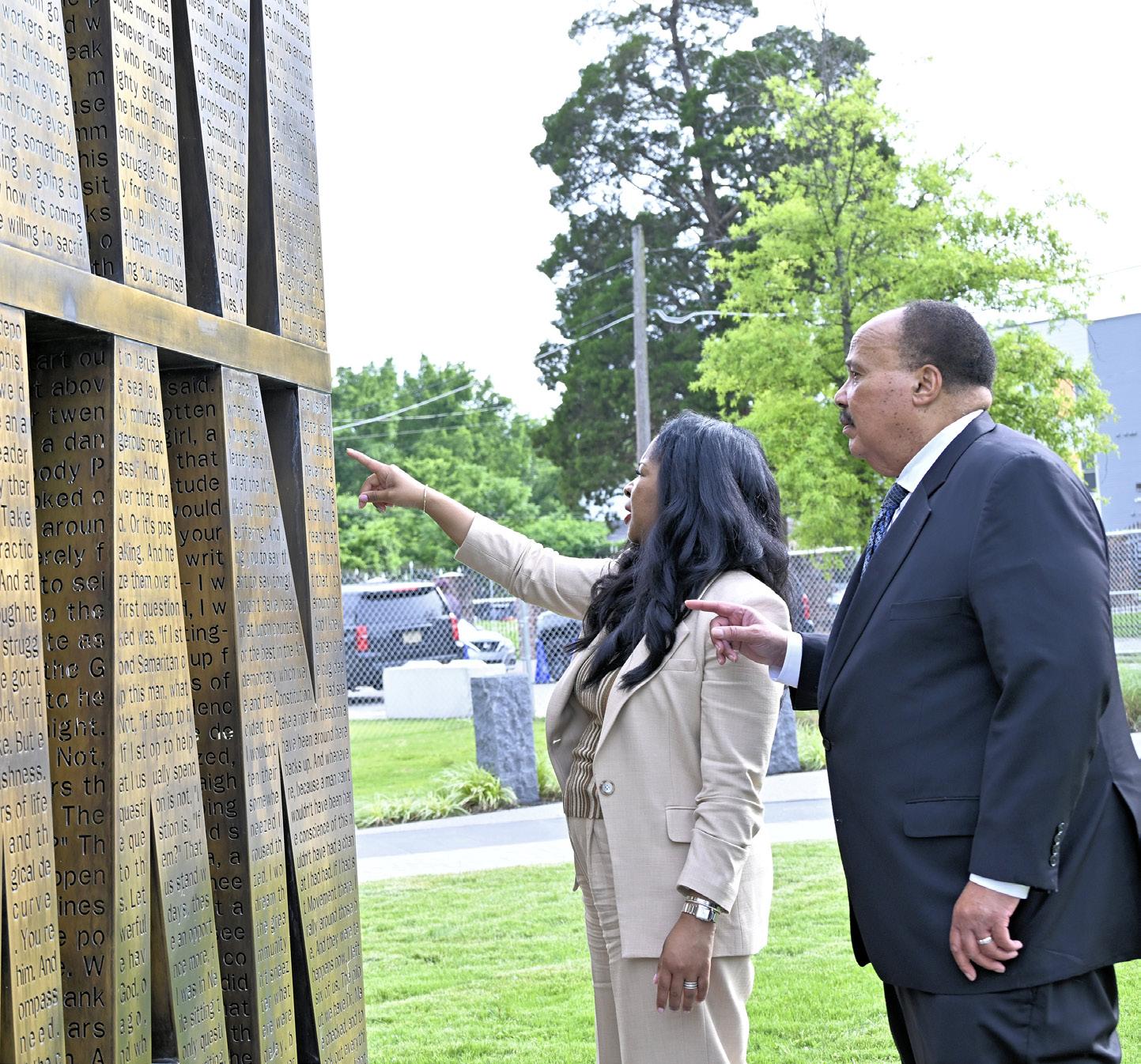

By James Coleman Special to The Tri-State Defender
Former Shelby County Sheriff’s Assistant Chief Reginald Hubbard has announced his candidacy for the 2026 Shelby County Sheriff’s race saying the community is “starved for a change.”
Hubbard made the announcement May 21 in front of the Shelby County Jail, located at 201 Poplar Ave. He spent the majority of his 36-year career in the Shelby County Jail Division before retiring in 2024.
“I worked one-third of my career in this building behind me,” Hubbard said. “I worked with all the officers here, changing policies, improving operations and helping the area grow.”
Hubbard’s campaign priorities include transparency, accountability and improving relations between the Shelby County Sheriff’s Office (SCSO) and the community.
“We have a plan. That plan is to address public safety,” he said. “We will emphasize collaboration between law enforcement and the community.”
One of the biggest issues facing the sheriff’s office — and possibly the county — is the deteriorating condition of the Shelby County Jail. Built in 1980, the facility has long been in need of repairs, including new jail doors, plumbing, HVAC systems and safety updates. Inmates continue to die at an alarming rate due to overcrowding, and critics have called for a new jail. Prominent voices advocating for a new facility include Sheriff Floyd Bonner and some members of the Shelby
“We could build a new jail tomorrow, but management has to improve. That’s the issue — management is not where it should be.”
— Reginald Hubbard
County Commission.
“I’ve been with the department long enough to understand the challenges it faces. Today, the Shelby County Sheriff’s Office is in crisis. These are not my words, but the words of the department itself,” Hubbard said.
Recently, state lawmakers rejected a proposed sales tax that would have funded a new jail. A recent budget proposal from Bonner pegged the cost of a new facility at more than $1 billion. In the meantime, Hubbard said he would focus on a “complete overhaul” of management within the current facility, including re-training existing staff or hiring new personnel.
“We could build a new jail tomorrow, but management has to improve,” Hubbard said. “That’s the issue — management is not where it should be.”
Another major concern is the length of time inmates spend in the facility. According to Hubbard, the average length of stay for a suspect awaiting trial is 2.5 years. Reform advocates have said some inmates have been held at the jail for over five years. Hubbard acknowledged the need for jail reform, but said the root cause lies within the
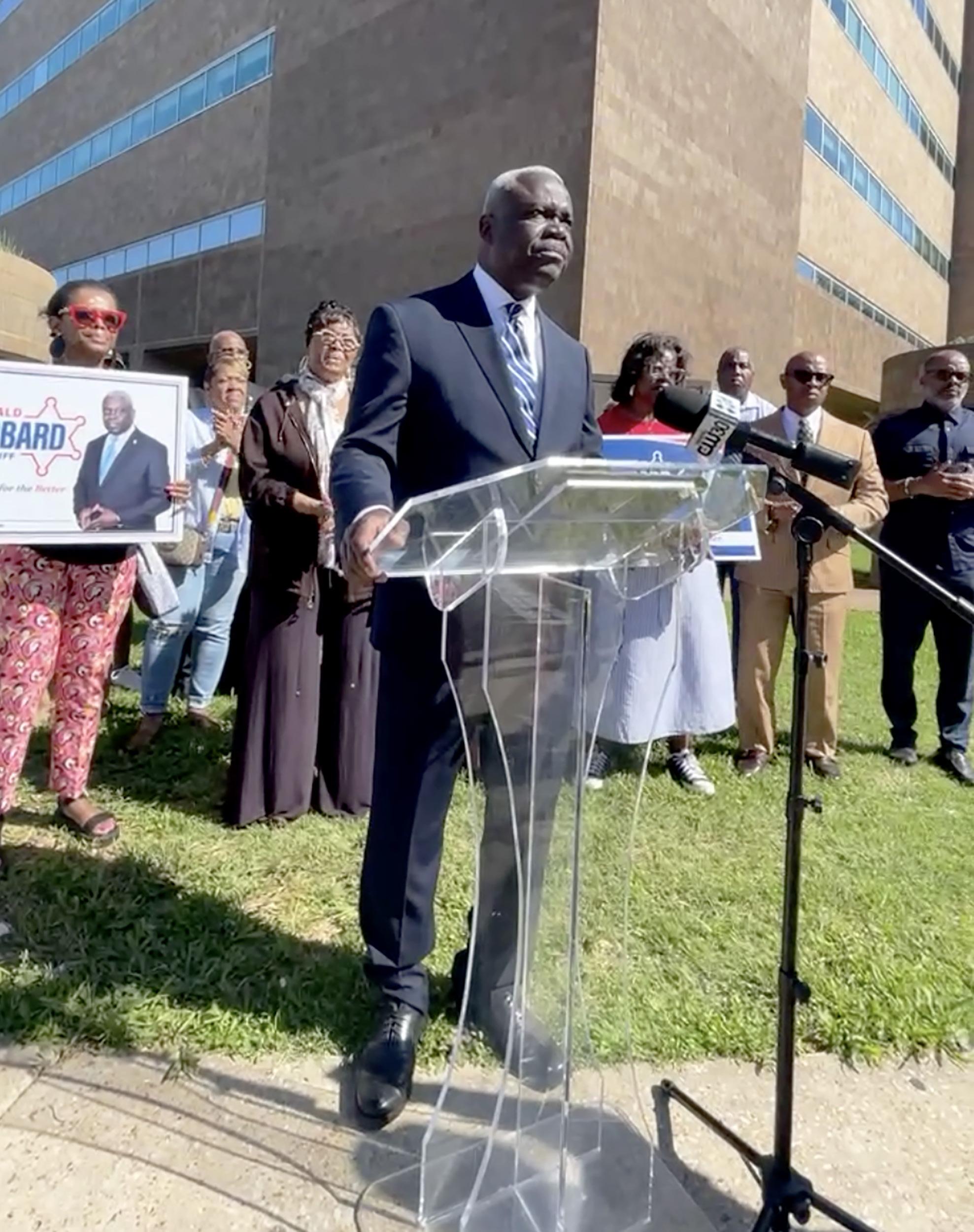
announces his candidacy for
the announcement May 21 in front of the Shelby County Jail, where he spent much of his 36-year career. He said the community is “starved for a change” as he seeks to bring new leadership to the office.
court system, which is outside the SCSO’s control. He has been in contact with external agencies to explore potential solutions.
Hubbard started his career at the jail as a deputy jailer, eventually rising to lieutenant. He managed staff, developed work assignments and ensured compliance with departmental procedures and state regulations. He also served as a patrolman.
A graduate of Overton High School, Hubbard holds a master of science in criminal justice from Bethel University
and a bachelor of business administration from LeMoyne-Owen College. He is married and the father of two children.
Hubbard is the fourth candidate to publicly announce a bid for sheriff, as of now, to replace Bonner, who is wrapping up his second and final term. The other candidates include SCSO Chief Deputy Anthony Buckner, Keisha Scott, who ran against Bonner in 2022, and former Memphis police officer Michael Pope. The Democratic primary election is May 5, 2026.
From Page 2
ing to meet staffing needs. Bonner has threatened legal action over the issue.
Harris’ administration has pushed back, arguing that using departmental fund balances is a common practice. Officials also contend that the unfilled positions in question likely won’t need to be staffed.
“You find out later the budget got balanced off the budget of the sheriff,” Ford said. “Last year, it was because of projections with the property tax, as well as what was going to be brought back by the sheriff — even though many of the things you asked for did not happen.”
Tensions between Ford and Harris have escalated in recent months, particularly following Harris’ push to revive the county ethics commission. That effort came shortly after Ford’s February indictment on federal charges of bribery and tax evasion. Prosecutors allege he sought grants for nonprofit organizations in exchange for those nonprofits making purchases from his personal tech businesses.
Whaley withdrew the ordinance to revive the ethics commission last week without comment.
Still, the fallout has continued. For weeks, Ford has carried a binder he claims contains information that could implicate “half” the commission. It reportedly includes ethics allegations against Harris, which were previously reviewed and dismissed by an outside attorney.
Meanwhile, Harris has advised his staff to avoid commission meetings after some were allegedly mistreated during prior sessions. The most notable absence Monday was the mayor himself.
“I personally had constituents come and verbally attack me on the record. I had to take it,” said Thornton. “If Mayor Harris wants to safeguard his appointees and employees, fine — but he should be here.”
Harris did appear later in the meeting to advocate for a group of nonprofits.
NOTICE
TO FURNISHERS OF LABOR AND MATERIALS TO ENSCOR, LLC. FOR THE BIG CREEK PARK SHADY OAKS PUMP STATION IMPROVEMENT PROJECT
Notice is hereby given that SHELBY COUNTY is preparing to make settlement with ENSCOR, LLC. for necessary and related work for the rehabilitation and/or construction of BIG CREEK PARK SHADY OAK PUMP STATION IMPROVEMENT PROJECT
All persons holding claims against the Contractor ENSCOR, LLC. or their agents for materials or labor entering into the construction of this project must file itemized notice of such claim (two copies) with the original copy sworn to before a Notary Public. This notice to be received at the office of James Gloster, Administrator of Purchasing, 5th Floor, 160 North Main, Memphis, Tennessee 38103, on or before June 30, 2025 in order to obtain the advantages afforded to claimants by legal statute.
Respectfully submitted, James Gloster Administrator of Purchasing Shelby County Government
LEGAL NOTICE Request for Bids RFB Number 25-0015
RENTAL CAR QUICK TURNAROUND BARRIER GATE REPLACEMENT
Sealed bids for Rental Car Quick Turnaround Barrier Gate Replacement will be received by the Memphis-Shelby County Airport Authority (Authority), Memphis International Airport –Receiving Dock, 4150 Louis Carruthers Drive, Memphis, TN 38118, until 2:00 PM local time, on July 10, 2025. Responses will be opened and publicly read thirty (30) minutes after the response deadline via Microsoft Teams: Join the meeting now
Meeting ID: 298 264 017 884 2
Passcode: YB76Qp3p
Download Teams | Join on the web
Or call in (audio only)
+1 872-242-8851, United States, Chicago Phone Conference ID: 254 982 050#
A complete Request for Bids Packet with submittal instructions, additional data, and response format may be found on the Authority’s website on or after May 23, 2025.
A mandatory pre-bid meeting followed by a site visit will be held June 12, 2025, at 1:00 p.m. at the Authority’s Board Room on the Mezzanine Level, Terminal B of the Memphis International Airport, 2491 Winchester Road, Memphis, TN 38116. Only those attending will be allowed to submit responses to this RFB. All attendees must register at www.eventbrite.com
All Bidders are responsible for checking the Authority’s website up to the submission deadline for any updates, addenda, or additional information. In accordance with the Authority’s purchasing policies, the Authority will give preference to businesses located in Shelby County, Tennessee when awarding contracts and making purchases, unless prohibited by law. The successful Bidder must sign a contract with the Authority that includes Federal Aviation Administration provisions, if applicable, regarding the Buy American Preference, Foreign Trade Restriction, Davis-Bacon, Affirmative Action, Debarment and Suspension, Prohibition on Certain Telecommunications and Video Surveillance Services or Equipment, Domestic Preferences for Procurements, and Drug-Free Workplace, all of which are incorporated herein by reference.
1509 Madison Ave.
Memphis, TN 38104
PH (901) 523-1818
HOURS: Mon.-Fri. 9 a.m. - 5 p.m.
DEADLINES:
Display ads Friday 5 p.m. Classifieds ads Monday 5 p.m.
STANDARD RATES: $8.00 per line for 1 column ad.
Rates are non-commissionable and are quoted at the net rate. No refund for early cancellation. For additional information contact Sales Dept. at (901) 746-5201 or email: advertising@ tsdmemphis.com.
THE TRI-STATE DEFENDER assumes
The Authority reserves the right to reject any or all responses to this Request for Bids in whole or in part; to waive any informalities, technicalities, or omissions related to this Request for Bids; and to reject responses on any other basis authorized by the Authority’s purchasing policies.
The Authority is an equal opportunity employer and prohibits discrimination based on the grounds of age, race, sex, color, national origin, disability, marital status, military service,
no financial responsibility for errors nor for copy omission. Direct any classified billing inquires to (901) 523-1818.
GENERAL INFORMATION:
The Tri-State Defender reserves the right to edit all copy or to reject or cancel any ad at any time. Copy change during ordered schedule constitutes new ad & new changes. Deadlines for cancellation are identical to placement deadlines. Rates subject to change. We can only offer in-house credit and NO REFUNDS are issued.
or sexual orientation in its hiring and employment practices and in the admission to, access to, or operation of its programs, services, and activities.
By order of: Terry Blue, A.A.E. President and CEO Memphis-Shelby County Airport Authority
